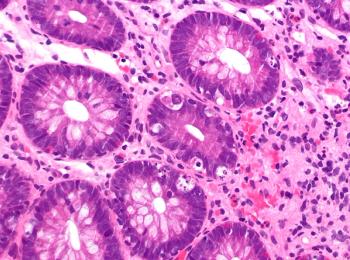
Blu-285 Shows Clinical Activity in Patients With Advanced Systemic Mastocytosis
In data presented at 2017 ASH, a highly selective inhibitor of KIT D816V is showing promise for advanced systemic mastocytosis, a hard-to-treat group of poor prognosis mast cell neoplasms.
A new agent that is a highly selective inhibitor of KIT D816V is showing promise for advanced systemic mastocytosis (AdvSM). Results from a phase I study presented during Sunday’s plenary session at the 2017 American Society of Hematology (ASH) annual meeting, held December 9-12 in Atlanta, Georgia, showed that BLU-285 appears to be well tolerated at the 300-mg dose. In addition, the study demonstrated considerable clinical activity in all AdvSM subtypes, even in those patients who have failed midostaurin and other anti-neoplastic therapies.
AdvSM consists of a group of poor prognosis mast cell (MC) neoplasms and includes aggressive systemic mastocytosis (ASM), SM with an associated hematologic neoplasm, and mast cell leukemia. Study investigator Daniel DeAngelo, MD, PhD, who is director of clinical and translational research of adult leukemia at Dana-Farber Cancer Institute and an associate professor of medicine at Harvard Medical School in Boston, Massachusetts, said KIT D816V is the driver in systemic mastocytosis and is seen about 90% of the cases. He said this agent is specifically designed to attack the mutant form of KIT.
Currently, the only approved agent to treat AdvSM is midostaurin. It is a multikinase inhibitor with a broad inhibitory spectrum that includes KIT D816V (IC50: 2.8 nM). BLU-285 is designed differently than midostraurin. It is a highly potent (IC50: 0.27 nM) and highly specific oral inhibitor of KIT activation loop mutants, including D816V. Researchers presented the latest results from an ongoing phase I study (ClinicalTrials.gov identifier:
The researchers found that this agent had significant clinical activity across all dose levels, with rapid and durable reductions in MC burden and D816V mutant allele fraction relative to baseline. “We were able to see all 32 patients in the study had reductions in their spleen size and in their bone marrow. The vast majority of patients are still on study. It is an exciting development in a disease that has very little options,” Dr. DeAngelo said in an interview with OncoTherapy Network.
The researchers found that BLU-285 was well tolerated. The most common adverse events were periorbital edema, anemia, diarrhea, fatigue, peripheral edema, headache, thrombocytopenia, and nausea. “This is a rare disease which has few options. Now, we have an option and hopefully it will be more efficacious in the long run,” said Dr. DeAngelo.
Newsletter
Stay up to date on recent advances in the multidisciplinary approach to cancer.
















































































